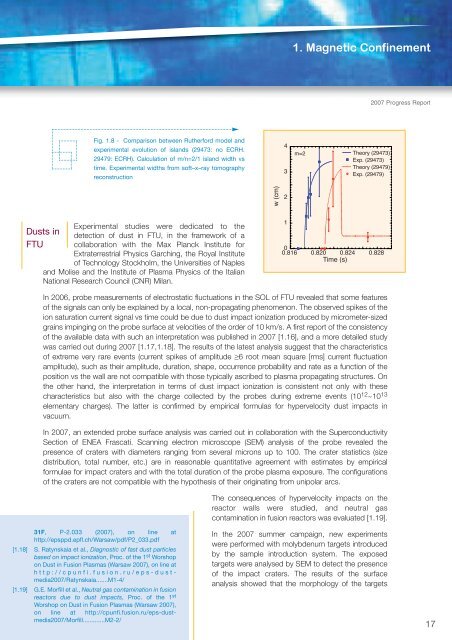Fusion Programme - ENEA - Fusione
Fusion Programme - ENEA - Fusione
Fusion Programme - ENEA - Fusione
- No tags were found...
You also want an ePaper? Increase the reach of your titles
YUMPU automatically turns print PDFs into web optimized ePapers that Google loves.
1. Magnetic Confinement2007 Progress ReportFig. 1.8 - Comparison between Rutherford model andexperimental evolution of islands (29473: no ECRH.29479: ECRH). Calculation of m/n=2/1 island width vstime. Experimental widths from soft–x–ray tomographyreconstruction43m=2Theory (29473)Exp. (29473)Theory (29479)Exp. (29479)w (cm)2Experimental studies were dedicated to theDusts in detection of dust in FTU, in the framework of aFTU collaboration with the Max Planck Institute forExtraterrestrial Physics Garching, the Royal Instituteof Technology Stockholm, the Universities of Naplesand Molise and the Institute of Plasma Physics of the ItalianNational Research Council (CNR) Milan.100.816 0.820 0.824 0.828Time (s)In 2006, probe measurements of electrostatic fluctuations in the SOL of FTU revealed that some featuresof the signals can only be explained by a local, non-propagating phenomenon. The observed spikes of theion saturation current signal vs time could be due to dust impact ionization produced by micrometer-sizedgrains impinging on the probe surface at velocities of the order of 10 km/s. A first report of the consistencyof the available data with such an interpretation was published in 2007 [1.16], and a more detailed studywas carried out during 2007 [1.17,1.18]. The results of the latest analysis suggest that the characteristicsof extreme very rare events (current spikes of amplitude ≥6 root mean square [rms] current fluctuationamplitude), such as their amplitude, duration, shape, occurrence probability and rate as a function of theposition vs the wall are not compatible with those typically ascribed to plasma propagating structures. Onthe other hand, the interpretation in terms of dust impact ionization is consistent not only with thesecharacteristics but also with the charge collected by the probes during extreme events (10 12 ~10 13elementary charges). The latter is confirmed by empirical formulas for hypervelocity dust impacts invacuum.In 2007, an extended probe surface analysis was carried out in collaboration with the SuperconductivitySection of <strong>ENEA</strong> Frascati. Scanning electron microscope (SEM) analysis of the probe revealed thepresence of craters with diameters ranging from several microns up to 100. The crater statistics (sizedistribution, total number, etc.) are in reasonable quantitative agreement with estimates by empiricalformulae for impact craters and with the total duration of the probe plasma exposure. The configurationsof the craters are not compatible with the hypothesis of their originating from unipolar arcs.The consequences of hypervelocity impacts on thereactor walls were studied, and neutral gascontamination in fusion reactors was evaluated [1.19].31F, P-2.033 (2007), on line athttp://epsppd.epfl.ch/Warsaw/pdf/P2_033.pdf[1.18] S. Ratynskaia et al., Diagnostic of fast dust particlesbased on impact ionization, Proc. of the 1 st Worshopon Dust in <strong>Fusion</strong> Plasmas (Warsaw 2007), on line athttp://cpunfi.fusion.ru/eps-dustmedia2007/Ratynskaia.......M1-4/[1.19] G.E. Morfill et al., Neutral gas contamination in fusionreactors due to dust impacts, Proc. of the 1 stWorshop on Dust in <strong>Fusion</strong> Plasmas (Warsaw 2007),on line at http://cpunfi.fusion.ru/eps-dustmedia2007/Morfill.............M2-2/In the 2007 summer campaign, new experimentswere performed with molybdenum targets introducedby the sample introduction system. The exposedtargets were analysed by SEM to detect the presenceof the impact craters. The results of the surfaceanalysis showed that the morphology of the targets17













